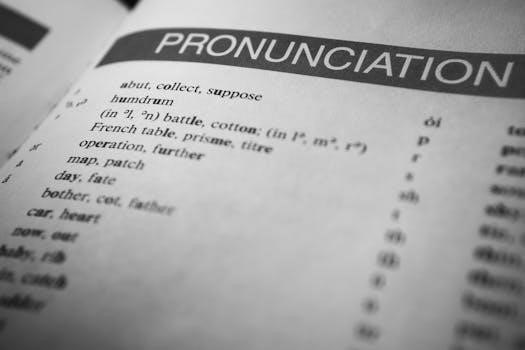
study guide and intervention 8 3
Overview of Study Guide and Intervention 8-3
Study Guide and Intervention 8-3 offers support for multiplying polynomials. It provides key concepts, worked-out examples, and exercises. The guide aims to assist students needing extra help. It covers distributing and FOIL methods.
Multiplying polynomials is a fundamental skill in algebra. It builds upon the distributive property and exponent rules. This section of the Study Guide and Intervention 8-3 introduces these concepts. It assumes familiarity with basic polynomial terminology. Understanding variables, coefficients, and degrees is crucial. Mastery of these basics ensures success. Multiplying monomials involves multiplying coefficients and adding exponents of like variables.
Polynomial multiplication extends this process to binomials, trinomials, and larger expressions. The study guide will walk through multiplying polynomials. Effective methods like the distributive property and FOIL method are shown. These methods systematically ensure each term gets multiplied correctly. Examples illustrate each technique. Practice problems reinforce understanding. This foundation prepares students for advanced algebraic concepts and problem-solving scenarios. Consistent practice solidifies skills and builds confidence. This section sets the stage for more complex applications.

Methods for Multiplying Polynomials
This section details methods for polynomial multiplication. The study guide covers the Distributive Property and FOIL method. These techniques ensure accurate multiplication. Examples illustrate each method.
Distributive Property
The Distributive Property is a fundamental method for multiplying polynomials, ensuring each term is correctly multiplied across. This technique is crucial when dealing with polynomials of any size, providing a systematic approach to expand expressions.
To apply the Distributive Property, each term in the first polynomial is multiplied by each term in the second polynomial. This process eliminates parentheses and creates a single, expanded polynomial expression. For example, when multiplying (a + b) by (c + d), ‘a’ is multiplied by both ‘c’ and ‘d’, and ‘b’ is multiplied by both ‘c’ and ‘d’, resulting in ac + ad + bc + bd.
This method is versatile and applicable to binomials, trinomials, and larger polynomials. Understanding and mastering the Distributive Property is essential for simplifying algebraic expressions and solving equations involving polynomials. It forms the basis for more advanced algebraic manipulations and is a cornerstone of polynomial arithmetic.
FOIL Method
The FOIL method is a specific application of the Distributive Property, designed for multiplying two binomials efficiently. FOIL stands for First, Outer, Inner, Last, representing the order in which terms are multiplied.
First⁚ Multiply the first terms of each binomial.
Outer⁚ Multiply the outer terms of the binomials.
Inner⁚ Multiply the inner terms of the binomials.
Last⁚ Multiply the last terms of each binomial.
After performing these multiplications, combine any like terms to simplify the resulting expression. For example, to multiply (x + 2) by (x + 3)⁚
First⁚ x * x = x²
Outer⁚ x * 3 = 3x
Inner⁚ 2 * x = 2x
Last⁚ 2 * 3 = 6
Combining like terms (3x and 2x), the final expression is x² + 5x + 6. The FOIL method provides a structured approach, reducing errors and ensuring completeness when multiplying binomials.

Examples of Polynomial Multiplication
Polynomial multiplication involves different methods depending on the complexity. Examples include multiplying binomials using FOIL and multiplying polynomials with more than two terms using distribution. Practice enhances understanding.
Multiplying Binomials
Multiplying binomials is a fundamental skill in algebra. This involves using methods like the Distributive Property and the FOIL method. The Distributive Property requires multiplying each term of one binomial by each term of the other binomial. For example, (x + 2)(x + 3) becomes x(x + 3) + 2(x + 3), then x² + 3x + 2x + 6, simplifying to x² + 5x + 6.
The FOIL method, standing for First, Outer, Inner, Last, is a mnemonic for the same process. First, multiply the first terms of each binomial; Outer, multiply the outer terms; Inner, multiply the inner terms; and Last, multiply the last terms.
Understanding these methods allows for efficient and accurate binomial multiplication. Practice with various examples solidifies this skill.
Multiplying Polynomials with More Than Two Terms
Multiplying polynomials with more than two terms extends the principles used with binomials. The key is to ensure each term in one polynomial is multiplied by every term in the other. This is achieved through repeated application of the distributive property.
For instance, to multiply (x + 2) by (x² + 3x + 4), distribute each term of the binomial across the trinomial. This results in x(x² + 3x + 4) + 2(x² + 3x + 4). Then, expand each term⁚ x³ + 3x² + 4x + 2x² + 6x + 8.
Finally, combine like terms to simplify⁚ x³ + 5x² + 10x + 8. This systematic approach works regardless of the number of terms in the polynomials. Careful organization and attention to signs are crucial for accuracy. Practice with diverse examples enhances proficiency in multiplying complex polynomials.

Applications of Multiplying Polynomials
Multiplying polynomials has diverse applications, including solving algebraic problems and modeling real-world scenarios. It’s useful in calculating areas, volumes, and financial models; These skills provide a foundation for advanced mathematical concepts and problem-solving techniques.
Solving Algebraic Problems
Polynomial multiplication is a fundamental skill in algebra, essential for solving various types of equations and simplifying expressions; This skill allows students to manipulate and combine algebraic terms, which is necessary for tackling more complex problems. Mastery of polynomial multiplication enables students to solve equations involving polynomial expressions.
Furthermore, multiplying polynomials is crucial when dealing with factoring problems. Factoring often involves reversing the process of multiplication, so a strong understanding of how to multiply polynomials makes factoring easier. It also plays a vital role in simplifying rational expressions, where both the numerator and denominator are polynomials. By multiplying polynomials, one can combine like terms and simplify complex fractions.
Polynomial multiplication is also applied in calculus and other higher-level math courses. The distributive property is essential for performing operations on functions. It’s a foundational skill for students pursuing advanced studies in mathematics, science, or engineering.

Additional Resources and Support
To further assist your learning, explore online materials and workbooks. Seek practice exercises with solutions for extra help. These resources reinforce concepts and build skills. Utilize all tools available.
Online Materials and Workbooks
Explore a variety of online resources designed to complement Study Guide and Intervention 8-3. Websites often provide interactive lessons, video tutorials, and practice quizzes to reinforce your understanding of polynomial multiplication. Look for resources that align with your textbook or curriculum for targeted support.
Workbooks offer additional opportunities for practice and skill-building. These resources typically include a wealth of exercises, ranging from basic to more challenging problems. Workbooks can be particularly helpful for students who benefit from a structured approach to learning.
Consider exploring online platforms that offer personalized learning experiences. These platforms can adapt to your individual needs and provide customized feedback to help you master polynomial multiplication. Many platforms also offer progress tracking tools, allowing you to monitor your improvement over time.
Don’t hesitate to utilize free online resources, such as Khan Academy, which provides comprehensive math tutorials and practice exercises. Remember to actively engage with the materials and seek help when needed.
Practice Exercises and Solutions
Engage with a wide array of practice exercises to solidify your understanding of multiplying polynomials. These exercises should cover various levels of difficulty, from basic binomial multiplication to more complex problems involving polynomials with multiple terms.
Focus on mastering the distributive property and the FOIL method, as these are fundamental techniques for polynomial multiplication. Work through examples that require you to combine like terms and simplify expressions.
Seek out practice problems that incorporate real-world scenarios or applications to enhance your problem-solving skills.
When working through the exercises, pay close attention to the solutions provided. Use the solutions to check your work and identify any areas where you may be struggling. If you encounter difficulties, review the relevant concepts and examples in the Study Guide and Intervention 8-3;
Consider working with a study partner or tutor to discuss challenging problems and gain different perspectives. Remember, consistent practice is key to mastering polynomial multiplication.